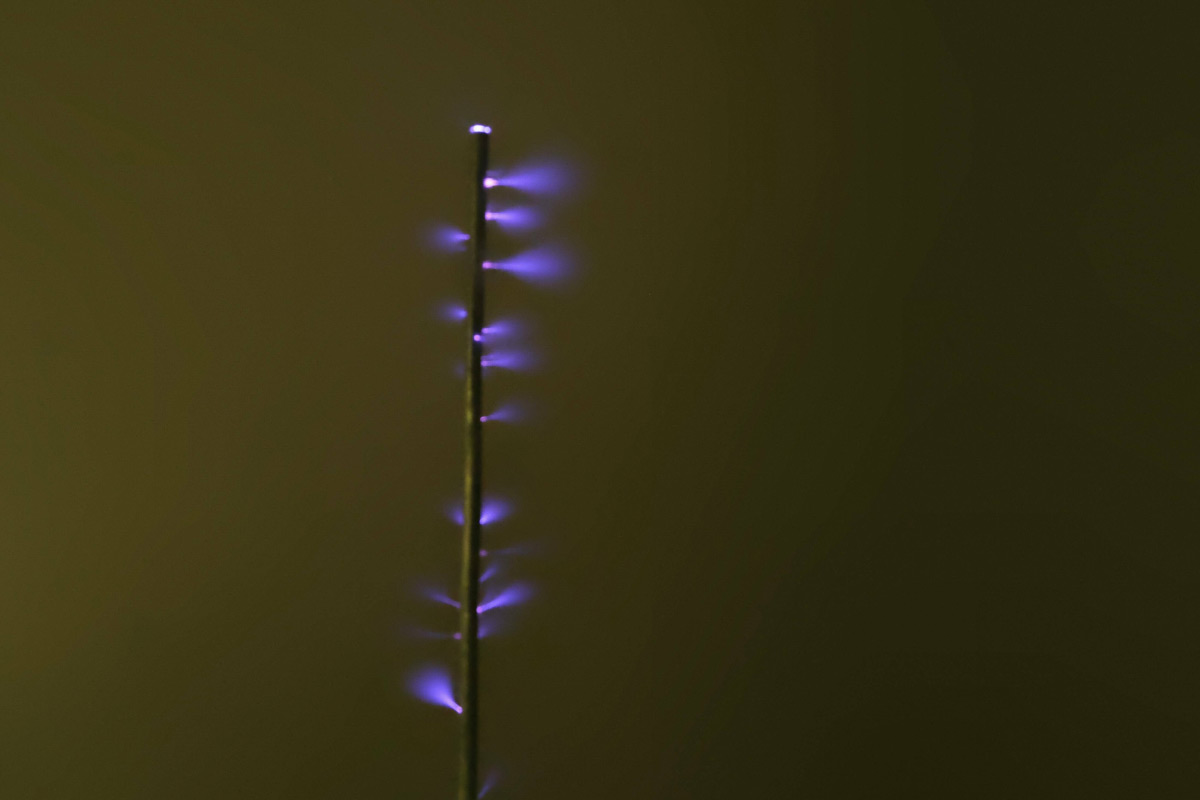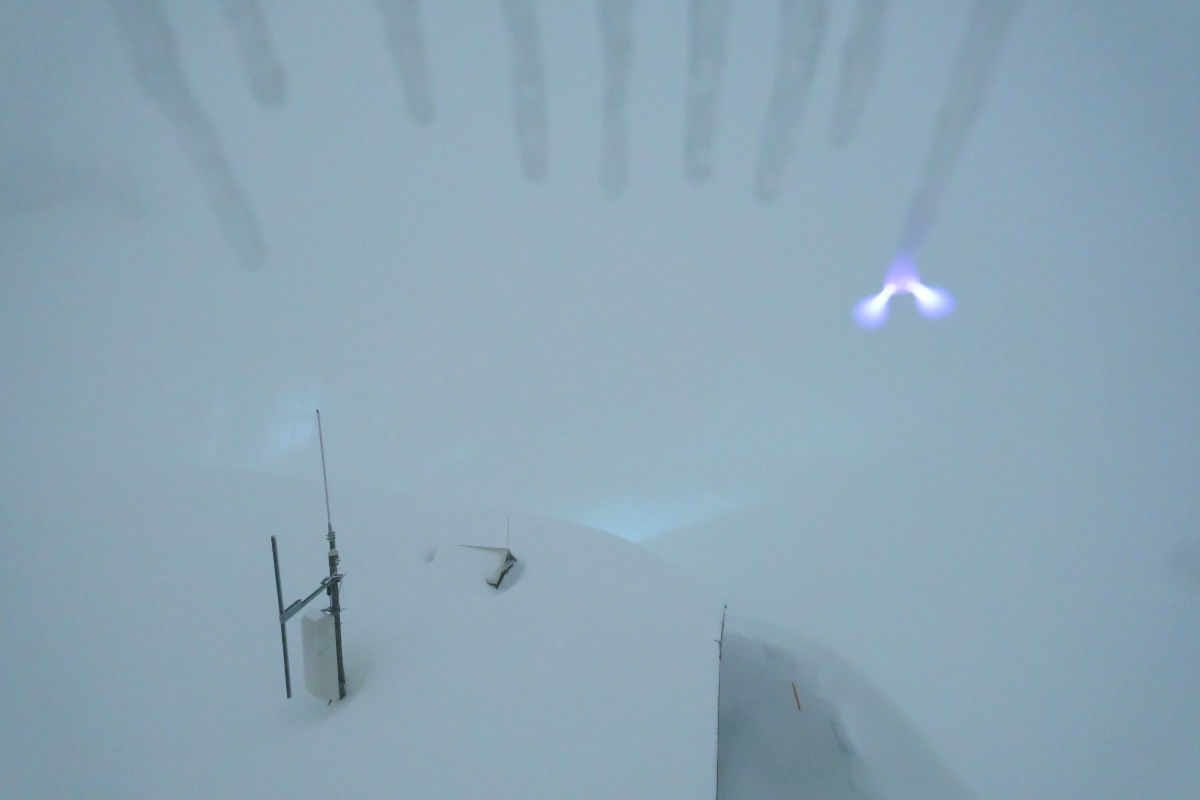St. Elmo's Fire is a blue-violet luminous phenomenon observed in the vicinity of thunderstorms, as well as during snowstorms and especially in the mountains with low-lying clouds. It tends to occur on pointed objects in exposed positions. The material of the object seems to play a minor role. The Elmo's Fire is accompanied by a characteristic crackling of the air, similar to that near high-powered power lines.
Explanation
Observation
Although St. Elmo's fire, for example, occurs frequently in the Alpine region, observations by people have become rare and difficult to achieve. While there is immediate danger to life during a summer thunderstorm with St. Elmo's fire, it is also not advisable to remain outside for too long during a winter snowstorm, often at temperatures as low as -20° Celsius. Here too, a lightning event cannot be ruled out as a potential danger.
In the literature, St. Elmo's fire is reported on church spires and ship masts. This phenomenon will hardly be perceptible there anymore due to the ubiquitous light pollution of today. Dark locations and, especially during thunderstorms, a Faraday cage are more suitable for observation.
Occurrence
Summit crosses, church spires, antennas, lightning rods, treetops, icicles, wooden poles, sharp-edged rocks, fingertips, hair tips, etc. On airplanes, St. Elmo's Fire very rarely occurs on measuring instruments, the axes of the windshield wipers, and the air intake of the turbine (according to professional pilots, max. 2 x a year). They are hardly noticed because they do not appear in the pilot's immediate field of vision. Glide discharges, which often occur on cockpit windows during takeoff and landing phases and near thunderstorms, are not to be equated with St. Elmo's Fire. These are not brush discharges, but voltage breakdowns on the "Faraday cage" of the aircraft.
Cause
The cause of this fascinating luminous phenomenon is considered to be an electric field generated by charge separation, which can occur in the vicinity of thunderstorms, but also during snowstorms, ice fog, and sandstorms. Voltage is created by the friction of individual particles (water droplets, snow, hail, sand, volcanic ash, etc.) in a cloud. When these particles collide, charge separation occurs. The positively charged particles gather in the upper part of the cloud, while the negatively charged particles collect in the lower part. The resulting voltages can become so extremely high that they reach up to 1,000,000,000 volts. At such field strengths, it can happen that the negatively charged particles near the ground are repelled by the negatively charged particles of the earth's surface. As a result of this process, the ground in this area becomes positively charged. If the electric field generated on the earth's surface exceeds a certain threshold, discharges occur in exposed areas through the air (corona discharge). The air molecules become ionized and begin to glow. Peaks, edges, and thin objects (rods) play a significant role: the field lines of the electric field are greatly concentrated in them, thereby significantly strengthening the field strength here. For this reason, St. Elmo's fire occurs preferentially at these pointed places.
Colors
The color of St. Elmo's fire is bluish-violet near the ground, resulting from the chemical properties of the nitrogen and oxygen molecules that become ionized here. The wavelengths of corona discharges are in the range of 230 to 450 nm. At higher altitudes (cruising altitude), St. Elmo's fire can glow green (ionized oxygen).
Origin
St. Elmo's fire (also known as Elias fire or Pickelsausen) is named after Erasmus of Antioch (Italian Elmo), a bishop and martyr who was venerated as a saint by the Roman Catholic Church. He was considered the patron saint of fire and was worshiped by Roman sailors when they were in distress due to storms or thunder. When sailors saw their sails glowing due to electrical charges, they associated this with St. Elmo's spirit and believed they were protected by him. Therefore, they named this phenomenon after him as St. Elmo's fire. In old writings, it is often mentioned that St. Elmo appeared with lit candles or torches on the masts and protected the ship from harm. The circumnavigator Ferdinand Magellan wrote in his ship's log at the end of the 15th century: "During the great storms, St. Elm was greeted on the masts with exclamations and tears of joy."
Miscellaneous
St. Elmo's fire is also known to occur on fingertips held up in high voltage. However, this is a life-threatening venture during a thunderstorm! If you see St. Elmo's fire nearby during a thunderstorm, there is an extreme risk of a lightning strike! The strong voltage difference can also manifest in objects audibly buzzing or hair standing on end. Even if this may look "funny," you should leave the area immediately in this situation, as a lightning strike is imminent.
Hoher Sonnblick
The photo webcam at the ZAMG Observatory Hoher Sonnblick at an altitude of 3106m was installed on 16.11.2012. The first St. Elmo's fire was recorded by this camera on 28.11.2012. Since then, it has been able to capture an average of 12.6 St. Elmo's fire events (observation days) per year, totaling 118. (As of 14.03.2022)



